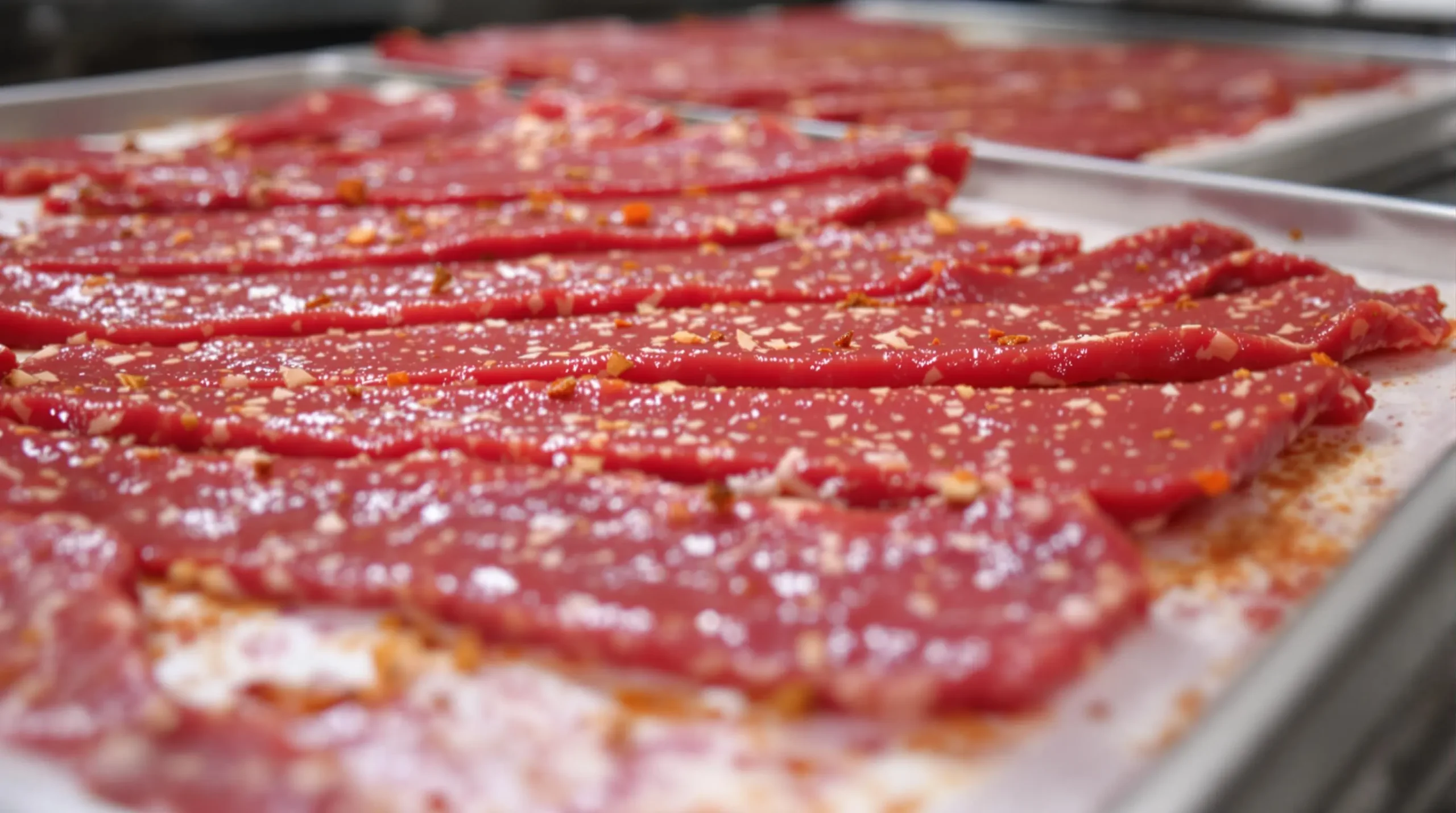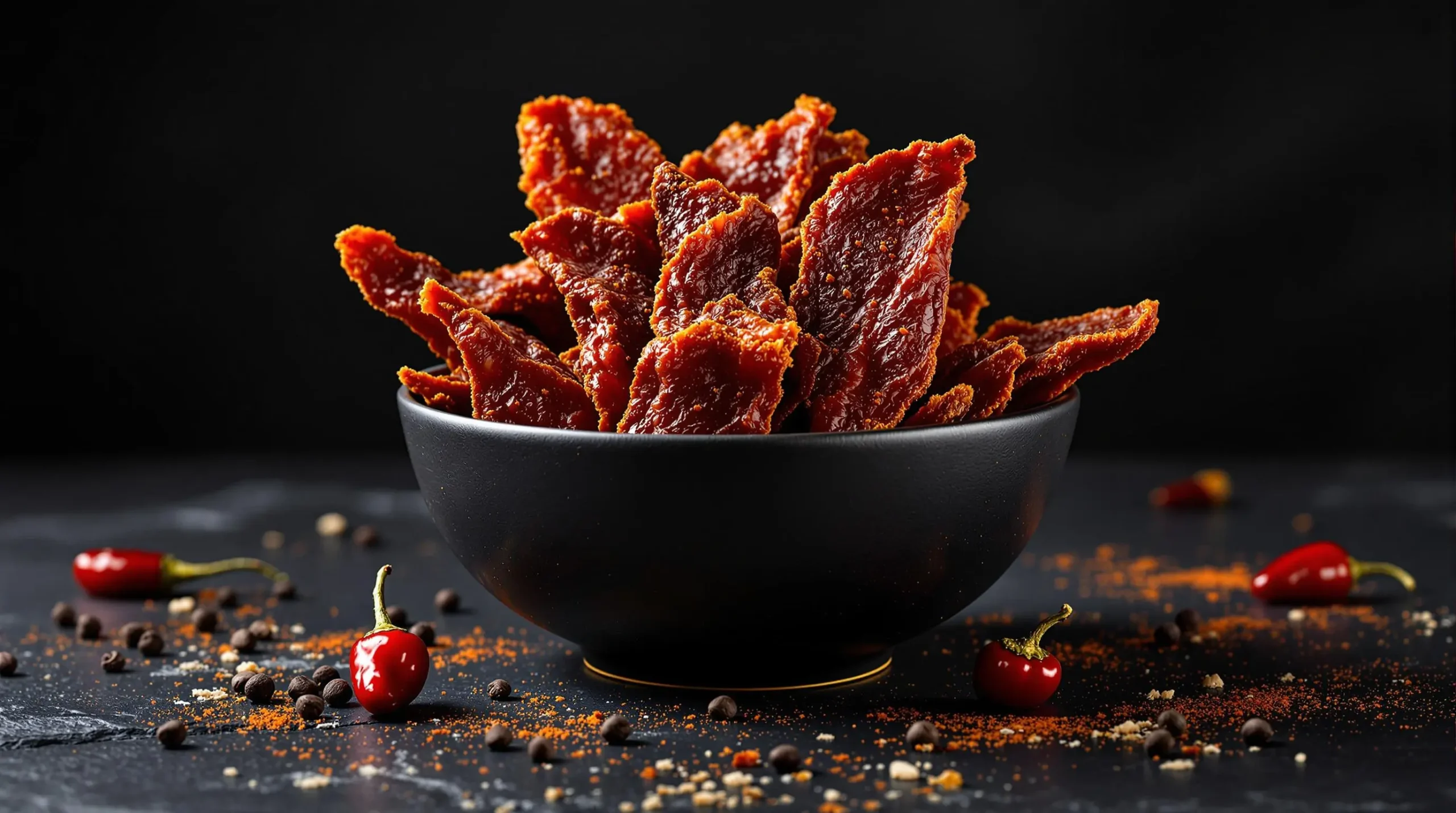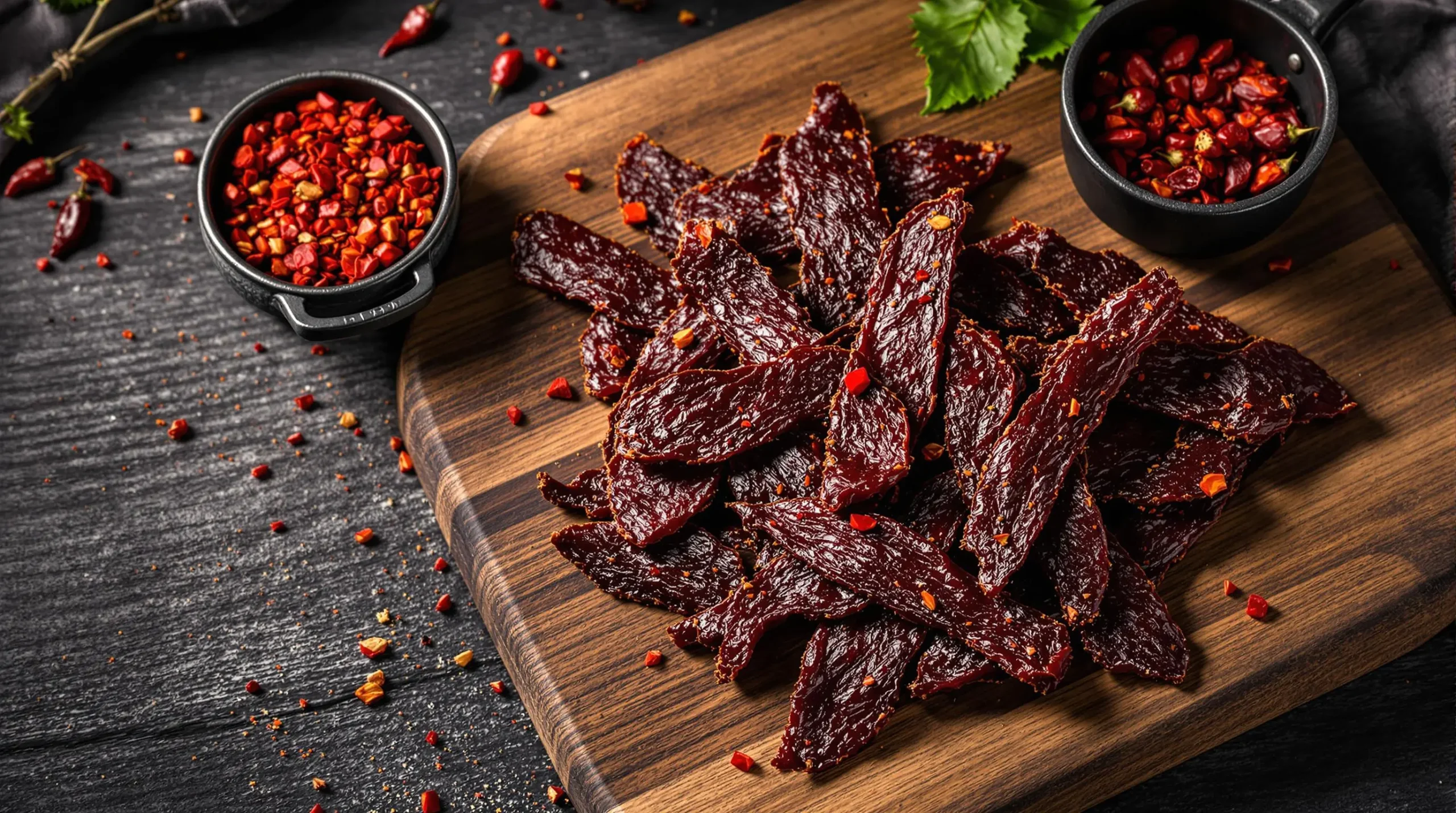Are you ready to experience the mind-blowing flavors of homemade spicy beef jerky? Once you try making this addictive snack at home, you’ll never go back to store-bought versions again. After perfecting my spicy beef jerky recipe through countless batches, I’m excited to share my foolproof method that delivers the perfect balance of heat and flavor every time.
Making jerky at home isn’t just satisfying – it’s also incredibly cost-effective. While premium jerky can cost upwards of $30 per pound at specialty stores, homemade versions typically run under $10 per pound. Plus, you have complete control over the ingredients and heat level, making it perfect for both mild heat enthusiasts and serious spice lovers. According to the Scoville Heat Scale, you can customize your kick from mild jalapeños to face-melting ghost peppers.
Following proper food handling is crucial for safe jerky making. Specific temperature controls, and selecting the right cut of beef is essential. I’ll show you how to choose the perfect meat and prepare it for optimal results.
In this guide, we’ll cover everything from essential equipment and ingredients to detailed marinating techniques and storage tips. Whether you’re a first-time jerky maker or looking to spice up your existing recipe, you’ll find all the information you need to create mouthwatering beef jerky at home. Let’s start with the basics of selecting the right cut of meat.
Essential Equipment and Ingredients for Spicy Beef Jerky
Before diving into the spicy beef jerky recipe preparation, let’s gather everything you’ll need for success. Having the right tools and ingredients makes a significant difference in the final product.
Required Equipment
Essential tools for your jerky-making arsenal include:
- Sharp knife or meat slicer for uniform cuts
- Large mixing bowls for marinating
- Plastic zip-top bags for marinading
- Paper towels for patting meat dry
- Cutting board (preferably with juice groove)
- Meat tenderizer (optional but helpful)
Best Meat Cuts for Jerky
The foundation of any great spicy beef jerky recipe starts with selecting the right cut of meat. Lean cuts with minimal marbling work best. Here’s why certain cuts stand out:
Eye of Round:
- Extremely lean with minimal waste
- Consistent grain for easy slicing
- Cost-effective option
- Perfect texture when dried
Top Round:
- Excellent meat-to-fat ratio
- Large, uniform pieces
- Easy to slice against the grain
- Great value for quantity
Alternative cuts like flank steak or sirloin tip can work well too, though they’re typically more expensive.
Marinade Components
The marinade is where your spicy beef jerky recipe truly comes alive. Start with these base ingredients:
Essential Liquid Base:
- Soy sauce (provides umami and salt)
- Worcestershire sauce (adds depth)
- Apple cider vinegar (tenderizes)
Spice Elements (adjustable to taste):
- Fresh habaneros (check the Scoville Scale for heat levels)
- Crushed red pepper flakes
- Black pepper
- Garlic powder
- Onion powder
Tenderizing Ingredients:
- Pineapple juice (natural enzyme break down)
- Lime juice (adds brightness)
- Brown sugar (balances heat and aids in preservation)

Remember, proper food handling is crucial when preparing marinades. We recommend refrigerating marinating meat immediately and avoiding cross-contamination.
Furthermore, keeping your marinade proportions consistent is key to reproducible results. I recommend measuring ingredients precisely rather than eyeballing them, especially when dealing with hot peppers. This ensures you can adjust the heat level in future batches based on your preferences.
Preparation and Marination Process for Spicy Beef Jerky
Now that we’ve gathered our ingredients, let’s dive into the crucial steps of preparing your spicy beef jerky recipe. The success of your jerky largely depends on proper preparation techniques and marination timing.
Meat Preparation
First and foremost, start with partially frozen meat for easier slicing. Maintaining meat at 40°F or below during preparation is essential for food safety. Here’s how to prepare your meat properly:
- Cut against the grain for tender jerky
- Maintain consistent 1/4-inch thickness
- Remove all visible fat to prevent spoilage
- Use a sharp knife or meat slicer for clean cuts
Additionally, trimming excess fat is crucial because it can turn rancid during the drying process. Moreover, fat prevents proper dehydration, potentially leading to spoilage.
Marinade Creation
The marinade is where your spicy beef jerky recipe truly develops its character. Adjust your pepper quantities to achieve your desired heat level.
- Combine all liquid ingredients in a large bowl
- Add dry spices and mix thoroughly
- Taste test (before adding raw meat)
- Adjust heat levels if needed
For the perfect marinade ratio, use:
- 1 cup liquid ingredients per pound of meat
- 2-3 tablespoons of combined dry spices
- 1-2 fresh peppers, finely diced (adjust based on heat preference)
Let the meat marinate for 12-24 hours in the refrigerator. Furthermore, massage the bag every few hours to ensure even distribution of flavors.
Pre-Dehydration Steps
Before starting the dehydration process for your spicy beef jerky recipe, proper preparation is crucial. Ensure your work surface and equipment are thoroughly sanitized.
- Remove meat from marinade
- Pat each piece thoroughly dry with paper towels
- Add additional dry spice coating if desired
- Arrange pieces with space between them
Tray Arrangement Tips:
- Leave space between meat pieces for air circulation
- Rotate trays every few hours for even drying
- Position fattier pieces on top trays
- Avoid overlapping pieces
Remember, proper spacing is essential for even dehydration. Additionally, placing a paper towel under the bottom tray catches any drips, making cleanup easier.
During the arrangement process, consider that pieces of similar thickness should be grouped together on the same tray. This ensures even drying times and consistent results. Subsequently, your jerky will be ready for the dehydration process, which we’ll cover in the next section.
By following these preparation steps carefully, you’ll be well on your way to creating perfect homemade spicy beef jerky that’s both safe to eat and delicious.
Dehydration and Storage for Perfect Spicy Beef Jerky
After careful preparation, the dehydration process is where your spicy beef jerky recipe transforms from marinated meat into a perfectly preserved snack. Let’s explore the critical steps for achieving the ideal texture and ensuring proper storage.
Dehydration Process
The key to successful jerky lies in maintaining consistent temperature and timing. Meat must reach an internal temperature of 165°F before the drying process begins to eliminate harmful bacteria.
Temperature and Timing Guidelines:
- Preheat dehydrator to 165°F for first hour
- Reduce to 145°F for remaining time
- Total drying time: 4-8 hours depending on thickness
- Check progress every 2 hours
To test for doneness, bend a piece of jerky at a 90-degree angle. Properly dried jerky should crack but not break completely. Additionally, the meat should be dry to the touch with no moisture pockets.
Storage Methods
Once your spicy beef jerky recipe has reached the perfect consistency, proper storage is crucial for maintaining freshness and preventing spoilage. We recommend specific storage methods for preserved meats.
Short-Term Storage Options:
- Airtight containers at room temperature (2 weeks)
- Refrigerated in sealed bags (3-6 months)
- Zip-top bags with moisture absorbers
- Mason jars with tight-fitting lids
Long-Term Preservation:
- Vacuum sealing extends shelf life up to 1 year
- Freezer storage in vacuum-sealed bags
- Multiple small portions rather than one large batch
- Label packages with date and spice level

Troubleshooting Tips
Even experienced jerky makers encounter challenges with their spicy beef jerky recipe. Here are solutions to common issues, including heat level adjustments.
Common Issues and Solutions:
- Too tough: Slice meat thinner or increase marination time
- Too dry: Reduce drying time or increase marinade oil content
- Uneven drying: Rotate trays and ensure consistent thickness
- Insufficient heat: Add fresh peppers to dry rub before drying
Heat Level Optimization:
- Test small batches with different pepper combinations
- Keep notes on pepper quantities and results
- Consider adding cayenne for consistent heat
- Mix hot and mild peppers for complex flavor
Furthermore, texture problems often stem from inconsistent slice thickness. Therefore, investing in a quality meat slicer can significantly improve results. Moreover, keeping detailed records of each batch helps perfect your recipe over time.
Remember that humidity levels can affect drying time, so adjust accordingly based on your climate. Subsequently, you may need to extend drying time in humid conditions or shorten it in dry environments.
By following these guidelines and making adjustments based on your results, you’ll soon be producing perfectly spiced, properly preserved beef jerky that rivals any commercial product.
Frequently Asked Questions About Spicy Beef Jerky
After sharing my spicy beef jerky recipe with hundreds of home cooks, I’ve collected the most common questions to help you achieve the best results. Here are the answers to your burning jerky-making questions.
How long does homemade spicy beef jerky last?
When properly dried and stored, your homemade jerky can last:
- 2 weeks at room temperature in an airtight container
- 3-6 months in the refrigerator
- Up to 1 year when vacuum-sealed and frozen
For best results, always check for any signs of moisture or mold before consuming stored jerky. Additionally, using moisture absorbers in your storage containers can significantly extend shelf life.
Can I make this recipe less spicy?
Absolutely! To reduce the heat level in your spicy beef jerky recipe, try these modifications:
- Replace hot peppers with milder varieties
- Reduce the amount of crushed red pepper flakes
- Add more brown sugar to balance the heat
- Use sweet paprika instead of cayenne
Furthermore, you can create a test batch by dividing your marinade and adjusting spice levels to find your perfect heat balance.
Why is my jerky too tough or too soft?
Texture issues usually stem from:
- Tough jerky: Slicing too thick or over-drying
- Soft jerky: Insufficient drying time or too much marinade
- Inconsistent texture: Uneven slice thickness
To fix these issues, ensure consistent 1/4-inch slices and check doneness regularly during drying.
Can I use an oven instead of a dehydrator?
Yes, though dehydrators provide more consistent results. For oven drying:
- Set temperature to lowest setting (usually 170°F)
- Prop door slightly open for airflow
- Place meat on racks over baking sheets
- Expect longer drying times (6-12 hours)
Moreover, use an oven thermometer to maintain proper temperature, and rotate racks every few hours for even drying.
Remember, regardless of your drying method, food safety is paramount. Therefore, always follow proper handling guidelines and ensure meat reaches the required internal temperature before consuming.
Conclusion: Mastering Your Spicy Beef Jerky Recipe
After exploring every aspect of creating the perfect spicy beef jerky recipe, you’re now equipped with all the knowledge needed to make incredible homemade jerky. The journey from selecting premium cuts of meat to achieving the ideal texture through proper dehydration may seem complex, but the results are truly worth the effort.
Remember that perfecting your jerky-making skills is an ongoing process. Start with small batches and keep detailed notes about your spice combinations, drying times, and results. Even slight adjustments in pepper quantities can significantly impact the final heat level of your jerky.
Key takeaways for success include:
- Always prioritize food safety
- Choose high-quality, lean cuts
- Maintain consistent slice thickness for even drying
- Allow adequate marination time for flavor development
- Monitor temperature and drying time carefully
Furthermore, don’t be afraid to experiment with different spice combinations and heat levels. Your spicy beef jerky recipe can evolve to match your exact taste preferences. Additionally, sharing your homemade jerky with friends and family can provide valuable feedback for future batches.
Ready to start your jerky-making adventure? Begin with a small batch using these guidelines, and you’ll soon be creating professional-quality spicy beef jerky that surpasses anything available in stores. Moreover, the satisfaction of crafting your own perfectly spiced, properly preserved snack is unmatched.

Remember, patience and attention to detail are your best allies in jerky making. Subsequently, each batch will bring you closer to mastering this rewarding culinary craft.

